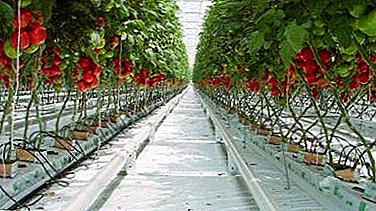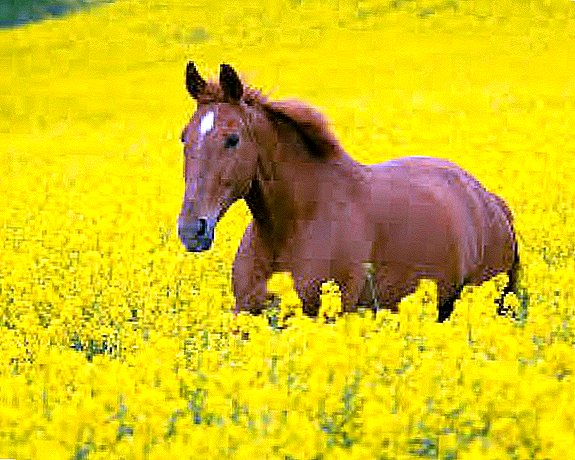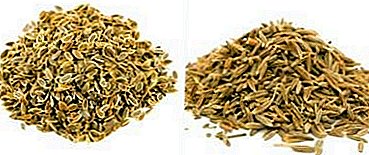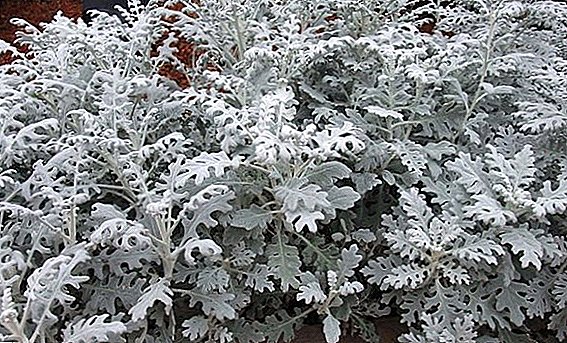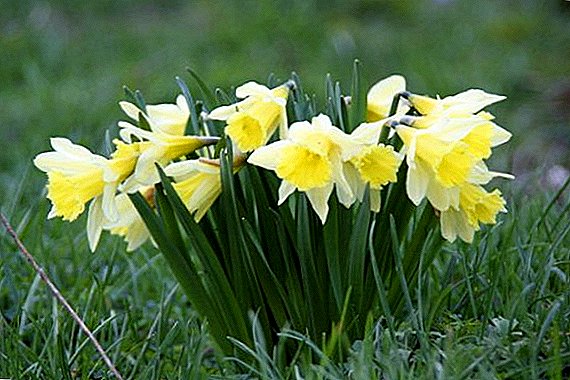 The beginning of spring for many is not connected with the date on the calendar, but with the appearance of the first flowers, such as narcissus. The bright colors of delicate flowers with large stamens after the gloomy landscapes of winter with blackened tree trunks touch even people indifferent to the colors.
The beginning of spring for many is not connected with the date on the calendar, but with the appearance of the first flowers, such as narcissus. The bright colors of delicate flowers with large stamens after the gloomy landscapes of winter with blackened tree trunks touch even people indifferent to the colors.
Choosing a place for a daffodil
For planting daffodil fit the area protected from the wind, with good lighting. The plant blooms well in the penumbra, it will suit the place under the trees or bushes with a sparse crown. The flower feels great in rock gardens, on lighted flower beds and flower beds, near artificial ponds. You should not plant it in areas where other bulbous or bouillonas grew, they are capable of transmitting their illnesses to the onions of the narcissus.  After the flower of the narcissus has blossomed, the leaves should dry themselves, and only then can they be removed. Given this circumstance, planting is better placed near coniferous trees or shrubs, late-flowering perennials, among the thick lawn grass. In this way, you will hide the unattractive appearance of the plant during the period of withering. When choosing a place, take into account the fact that in one area a daffodil can grow up to six years.
After the flower of the narcissus has blossomed, the leaves should dry themselves, and only then can they be removed. Given this circumstance, planting is better placed near coniferous trees or shrubs, late-flowering perennials, among the thick lawn grass. In this way, you will hide the unattractive appearance of the plant during the period of withering. When choosing a place, take into account the fact that in one area a daffodil can grow up to six years.
How to plant a daffodil in open ground
Optimum soil characteristics:
- friability;
- water and air permeability;
- acidity pH 6.5-7.8;
- groundwater flow is not higher than 60 cm from the surface.
When can I plant a daffodil
The best time for planting is autumn to early October. Daffodil bulbs take root within a month, so choose the time of planting before the onset of frost. If the flower does not have time to get stronger - will die. Possible landing in early spring. The main condition - the earth should warm up to 20 centimeters in depth.
Features of landing in the spring
Before planting daffodil bulbs plants need some procedures. First of all, poor quality planting material is rejected: soft, damaged, bad-smelling and diseased bulbs. Healthy selected bulbs need to be treated with a spray of "Fundazole" or hold in a solution of potassium permanganate for half an hour. After processing, dry the seedlings well.
 Land for planting should also be prepared: dig a half bayonet for a shovel. If the area is heavy clay soil, "dilute" with peat and sand, sour - add lime or dolomite flour. It is advisable to fertilize the soil with humus and wood ash. Determine the depth of the holes for planting, guided by the size of the onion and the structure of the soil, they should be approximately 12-18 cm. After planting, water and slightly compact the soil. Do not forget that the bulbs of daffodils, planted in the spring, bloom much later than autumn.
Land for planting should also be prepared: dig a half bayonet for a shovel. If the area is heavy clay soil, "dilute" with peat and sand, sour - add lime or dolomite flour. It is advisable to fertilize the soil with humus and wood ash. Determine the depth of the holes for planting, guided by the size of the onion and the structure of the soil, they should be approximately 12-18 cm. After planting, water and slightly compact the soil. Do not forget that the bulbs of daffodils, planted in the spring, bloom much later than autumn.
How to plant a daffodil in the fall
Preparing the soil for the autumn planting is to create a nutrient layer of at least thirty centimeters. To do this in equal parts mixed: peat, large river sand, humus and sod land.
Important! Coarse river sand is needed in the soil as a drainage. Stagnant moisture will cause fungal infections and the death of onions.
It would not be superfluous to add the mineral composition superphosphate (2 tbsp. L.) And potassium (1 tbsp. L.) Per square meter. The site is dug up and leveled with the help of a rake. All these procedures need to be done a month before landing.  Planting depth is determined by the size of the bulbs and the condition of the soil - from 15 to 25 cm. Leave up to 70 cm between rows. If you want to get a lot of children, plant the bulb to a depth of 12 cm. After autumn planting, you need to mulch the soil and cover it with lapnik or turf This will protect against frost and rodents.
Planting depth is determined by the size of the bulbs and the condition of the soil - from 15 to 25 cm. Leave up to 70 cm between rows. If you want to get a lot of children, plant the bulb to a depth of 12 cm. After autumn planting, you need to mulch the soil and cover it with lapnik or turf This will protect against frost and rodents.
Did you know? Long since the narcissus was admired and endowed with various qualities. The ancient Greeks considered the flower a symbol of death, applying it in funeral rites. Europe in the heyday of the Renaissance revered narcissus as a symbol of love and marriage bonds. In the East, the flower personifies the eyes of the beloved; in Italy, a bouquet of daffodils means a declaration of love.
Basic rules for the care of daffodils
A very important moment in the care of daffodils in the garden is weeding, loosening and tilling the soil. Onions need oxygen for development and flowering. Harvesting weeds will provide a good supply of nutrients to the plant.
Watering plants
 As soon as the snow melts, the bulbs planted in autumn need watering. When planting, take care of drainage in the soil so that moisture does not stand at the roots of the plant. At the end of April, the buds of daffodils are laid; water is simply vital during this period. The moisture remaining after the melting of the snow has already evaporated, so you should provide watering. In case of insufficient watering, the buds can wither without having dissolved. It is advisable not to wet the buds so that the water does not damage the petals. After a flowering period, the plant must be watered for a month so that the bulbs have time to absorb all the nutrients for wintering.
As soon as the snow melts, the bulbs planted in autumn need watering. When planting, take care of drainage in the soil so that moisture does not stand at the roots of the plant. At the end of April, the buds of daffodils are laid; water is simply vital during this period. The moisture remaining after the melting of the snow has already evaporated, so you should provide watering. In case of insufficient watering, the buds can wither without having dissolved. It is advisable not to wet the buds so that the water does not damage the petals. After a flowering period, the plant must be watered for a month so that the bulbs have time to absorb all the nutrients for wintering.
Features feeding narcissus
Narcissus begins to feed during the emergence of the first shoots. Use in this mineral composition (1 tablespoon. Ten liters of water). The first dressing is combined with irrigation. The second fertilizer is carried out during the budding period. To do this, prepare the mixture: add ten teaspoons of superphosphate, urea and potassium sulfate to ten liters of water. The third time the plant is fed with a fully formed bud, making mineral fertilizers: nitrogen, phosphorus and potassium. The final dressing is carried out during the flowering period of phosphorus-potassium compounds.
Attention! In rainy weather it is better to use granular or powder fertilizers, and in dry it is liquid. From organic dressings it is better to use four-year manure, bone meal (source of phosphorus). Organics contribute after weeding.
Plant Transplant Rules
In addition to knowing how to care for daffodils in the garden, you need to know the rules of flower transplantation. The best time for this procedure is autumn. In order for flowers to retain their appearance and ability to bloom for a long time, it is necessary to plant them once every three to five years.
A few days before the transplant, cover the flower garden or flower bed with a film to warm the soil. Dig the bushes of daffodils together with the earthy clod and lay them out on film or paper. The plant needs to be examined, to remove weak or diseased sprouts and, if necessary, to divide.  At the place chosen for planting, dig holes under the bush, lay a thin layer of three-year-old humus on the bottom, crushed eggshell and a pinch of ash. Lay the plant on the bottom, sprinkle, compact the soil and pour in plenty. After two weeks, water again. Further care is the same as after landing. During the formation of buds, soil the soil with granules of mineral fertilizer.
At the place chosen for planting, dig holes under the bush, lay a thin layer of three-year-old humus on the bottom, crushed eggshell and a pinch of ash. Lay the plant on the bottom, sprinkle, compact the soil and pour in plenty. After two weeks, water again. Further care is the same as after landing. During the formation of buds, soil the soil with granules of mineral fertilizer.
Reproduction of daffodil
The reproduction of daffodils is carried out by seed and vegetative methods. Breeders for breeding new hybrids artificially pollinate plants and long wait for the seeds to mature. We will consider more simple breeding methods.
Interesting! The ancient Greek myth tells about the beautiful young man Narcissus, who rejected the love of the nymph Echo. The angry nymph doomed Narcissus to narcissism, the young man remained forever lying by the stream, admiring his own reflection in the water. There, where his head lay, grew a delicate flower with a bowed head. And the name Narcissus has since become a household name.
Seed propagation
 For this method of reproduction, seeds not dried after harvesting are planted in boxes in a warm climate in the ground to a depth equal to three times the size of the seed. They are looked after, as well as the seedlings - with watering and fertilizing. The first years of the shoots do not touch, giving the bulb time to get stronger and form the root system. Then they are looking for a permanent place, transplanted, following all the rules of landing. Such plants bloom in six to seven years.
For this method of reproduction, seeds not dried after harvesting are planted in boxes in a warm climate in the ground to a depth equal to three times the size of the seed. They are looked after, as well as the seedlings - with watering and fertilizing. The first years of the shoots do not touch, giving the bulb time to get stronger and form the root system. Then they are looking for a permanent place, transplanted, following all the rules of landing. Such plants bloom in six to seven years.
Vegetative reproduction
In the third year of life, the bulb is able to form a sufficient number of children. Onions are disconnected from the mother and seated in separate pits. Care of them consists in watering, top dressings and loosening of the soil.
Another method - reproduction scales. For this method, choose the largest bulbs. Within a week they are dried at a temperature of twenty degrees. Next, perform the following actions:
- Cleared of roots and upper scales.
- Disinfected in a solution of "Fundazol" for half an hour.
- Cut off the top of the bulb and divide it into eight parts along.
- Each delenka should have paired scales with a common base weighing at least a gram.
- Disinfect the scales "BenLatom", peppered and poured into a package.
- At temperatures from 17 to 20 degrees, the scales are kept in a closed package for three to four months. During this time small onions should be formed.
 The work time should be calculated so that in October, young bulbs should be removed from the package and, after clearing of scales and disinfecting, plant the seedlings in boxes with peat and sand (three to one). The box with landing define in the room with a temperature from five to ten degrees for the winter period. In the fall, developed and matured bulbs can be planted in the ground.
The work time should be calculated so that in October, young bulbs should be removed from the package and, after clearing of scales and disinfecting, plant the seedlings in boxes with peat and sand (three to one). The box with landing define in the room with a temperature from five to ten degrees for the winter period. In the fall, developed and matured bulbs can be planted in the ground.Major pests and diseases of the flower
Most often, diseases and pests attack daffodils due to improper planting or care. The main causes of problems are:
- non-compliance with the storage rules for planting material (temperature, humidity);
- disinfection of bulbs;
- excess nitrogen supplements;
- lack of lighting.
These slips can lead to diseases and pests.
 Most often, daffodils are invaded by nematodes, a bear, snails, ticks, and a narcissus fly. Nematos and Carbation drugs are used against nematodes. From a narcissus fly helps a two percent solution of "Fufanon." Against ticks, there is a folk method - spray a plant with tobacco solution or marigold infusion. For prophylaxis during the budding period, spray the plant "Fitoverm" into ten square meters of 2 ml per 1 liter of water.
Most often, daffodils are invaded by nematodes, a bear, snails, ticks, and a narcissus fly. Nematos and Carbation drugs are used against nematodes. From a narcissus fly helps a two percent solution of "Fufanon." Against ticks, there is a folk method - spray a plant with tobacco solution or marigold infusion. For prophylaxis during the budding period, spray the plant "Fitoverm" into ten square meters of 2 ml per 1 liter of water.
If plants are infected with an infection, they must be urgently dug out so as not to infect healthy flowers. Steam healthy bulbs in hot water (45 degrees) for about three hours. At the same time the soil should be treated with "Carbathion". To avoid such troubles, treat seedlings with fungicides, during storage, follow all recommendations.
How to care for daffodils after flowering
Daffodils bloomed, what to do next? Then they need to prepare for the winter. In faded plants it is impossible to cut and remove the leaves, they must dry naturally, and their juices will go to the bulbs wintering in the ground. After the flowering stops, the plant continues to be watered in order for the bulbs to get enough nutrients.
Daffodils are frost-resistant, but in the absence of snow they can die. The plant will have the worst of it if during a long thaw it wakes up and begins to germinate. Such a plant will die when the frost returns. When the foliage of the narcissus withers and withers away, it needs to be removed and the soil raised. The area with the remaining bulbs should be covered with mulch: peat, straw, special materials (agrospan or spunbond) with a layer of fifteen centimeters.  What needs to be done if you do not want to leave the bulbs for the winter when the daffodils bloom? Here you need to wait for the natural wilting of the plant, and then with a garden fork gently dig up the bulbs. Put them in a cool dark place to dry. When the bulbs are dry enough, separate the babies from the mother bulb, sort them, discarding the soft and damaged ones. The selected quality material must be disinfected in a solution of manganese and dried in warm (+ 22-25 degrees). The room must be ventilated. Store onions until planting should be in a dark room at a temperature of 18 degrees.
What needs to be done if you do not want to leave the bulbs for the winter when the daffodils bloom? Here you need to wait for the natural wilting of the plant, and then with a garden fork gently dig up the bulbs. Put them in a cool dark place to dry. When the bulbs are dry enough, separate the babies from the mother bulb, sort them, discarding the soft and damaged ones. The selected quality material must be disinfected in a solution of manganese and dried in warm (+ 22-25 degrees). The room must be ventilated. Store onions until planting should be in a dark room at a temperature of 18 degrees.
If you decide to decorate the plot with daffodils, take into account the fact that there are early and late varieties of flowers. Planting on the site and those, and others, you will admire flowering more than one month. Decorate with these flowers beds, rock gardens, lawns. Borders and compositions with other spring flowers look original.





